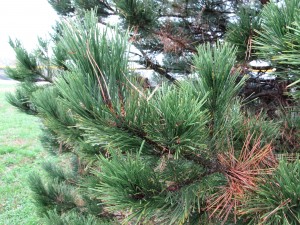Some needle loss on evergreens in the fall is natural. As night time temperatures cool, needles in the interior of many evergreen trees or shrubs regularly turn brown (or golden yellow) and drop off. Needle loss is most obvious on pines (Pinus spp.) and arborvitae (Thuja spp.) in the Southern Appalachian region (USDA zones 6 and 7).
The numbers of needles shed may vary from one year to the next. Unusually high needle losses may be a reaction to high summer heat and extended dry periods within the geographical area where you live.
Loss of two year and older needles is natural. Loss of current season and last year’s needles is painfully not a good thing and may be caused by a disease or insect pest. Roots of evergreens may contract a root disease such as pythium and phytophthora fungi. Often, a root disease may be fatal or the pesticide treatment(s) very costly.
Environmental and transplanting stresses may be the cause. Winter desiccation and de-icing salts can turn evergreens brown. Needle losses are usually higher on newly planted evergreens.
Weekly deep watering in the fall and late winter fertilizing of evergreens helps relieve transplant stress. Transplant shock (heavy needle loss) should not re-occur the following fall.
Note: More on fall-winter care of evergreens coming soon.


 Posted in
Posted in 
